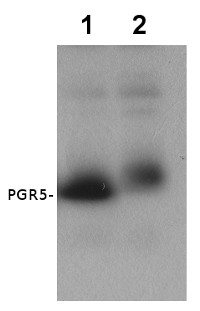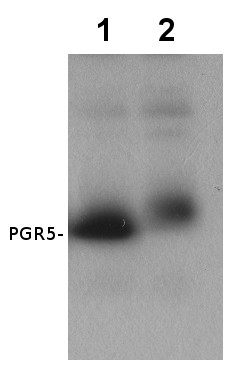1

PGR5 | Proton gradient regulation 5
AS16 3985 | clonality: polyclonal | host: rabbit | reactivity: Arabidopsis thaliana, Picea abies, Pinus sylvestris, Solanum lycopersicum
- Data sheet
-
- Product Info
-
Immunogen: KLH-conjugated peptide derived from Arabidopsis thaliana PGR5, UniProt: Q9SL05, TAIR: AT2G05620
Host: Rabbit Clonality: Polyclonal Purity: Serum Format: Lyophilized Quantity: 50 µl Reconstitution: For reconstitution add 50 µl of sterile water Storage: Store lyophilized/reconstituted at -20°C; once reconstituted make aliquots to avoid repeated freeze-thaw cycles. Please remember to spin the tubes briefly prior to opening them to avoid any losses that might occur from material adhering to the cap or sides of the tube. Tested applications: Immunoprecipitation (IP), Western blot (WB) Recommended dilution: 1: 1000 - 1: 5000 (WB)
Expected | apparent MW: 14,29 kDa - Reactivity
-
Confirmed reactivity: Arabidopsis thaliana, Picea abies, Pinus sylvestris, Solanum lycopersicum Predicted reactivity: Amaranthus hybridus, California macrophylla, Cucumis melo, Cucumis sativus, Erodium gruinum, Francoa sonchifolia, Geranium phaeum, Gossypium hirsutum, Helianthus annuus, Hypseocharis bilobata, Juglans regia, Klebsormidium nitens, Medicago truncatula, Melianthus villosus, Monsonia marlothii, Nelumbo nucifera, Nicotiana sylvestris, Nicotiana tabacum, Noccaea caerulescens, Pelargonium dichondrifolium, Physcomitrium patens, Pinus taeda, Populus sp. , Portulaca oleracea, Spinacia oleracea, Theobroma cacao, Trifolium pratense, Zea mays, Zostera marina, Vitis vinifera
Species of your interest not listed? Contact usNot reactive in: diatoms, Chlorella sp., cyanobacteria - Application Examples
-

Thylakoids were isolated according to Sirpiö et al (2011, Methods Mol Biol. 2011; 775:19-30). 3 µg/µl of total chlorophyll from Arabidopsis thaliana col-0 (1) and Arabidopsis thaliana pgr5 mutant (Munekage et al. 2002, Cell) (2) were denatured in Laemmli buffer at room temperature (15 min) were separated on 12 % SDS-PAGE mini-gels with 6 M urea and blotted for 1h to a PVDF membrane using a semi-dry transfer. Membranes were blocked with 5% milk in TBS for 1h at room temperature and incubated in antisera (1:1000 in 1 % milk/TTBS) overnight at 4°C with slow agitation, then in secondary antibody (anti-rabbit IgG HRP conjugated, AS09 602, Agrisera) 1:20 000 in 1% milk/TTBS) for 2 hours at RT with slow agitation. Blots were detected for 5 min with a chemiluminescent substrate. Exposure time was 2 min.
The pgr5 mutant has a point mutation that affects the function of the PGR5 protein, therefore a band is still seen in the western blot.
Courtesy Dr. Peter Gollan, University of Turku, Finland
Experimental conditions for detection in extracts of Picea abies and Pinus sylvestris:
25 µg/well of total protein extracted from needles of Picea abies and Pinus sylvestris. Exact buffer components were: 10% trichloroacetic acid (TCA)/ acetone buffer. Then followed by a methanol buffer (80% methanol with 0.1 M ammonium acetate) wash and an 80% acetone wash step. Subsequently, total of 1.8 ml mixture of 1:1 phenol (pH 8.0)/SDS buffer (30% sucrose, 2% SDS, 0.1M Tris-HCl, pH 8.0, 5% 2-mercaptoethanol) were added to the tube to extract proteins from dry pellets. After centrifuging at 16,000 g, 4 °C for 3 min, 0.4 ml phenol phase extraction were mixed with 1.6 ml methanol buffer and then centrifuged at 16,000 g, 4 °C for 3 min. The pellets were washed twice with methanol and 80% acetone. Final protein pellets were dissolved in 0.2 ml Laemmli sample buffer, and denatured at 100 °C for 10 min. Samples were separated in the cold on 12 % SDS-PAGE and blotted for 1 h to PVDF membrane, using: wet transfer in the cold. Blot was blocked with 5 % milk for: 1h/RT with agitation. Blot was incubated in the primary antibody at a dilution of 1: 1000 for ON/4°C with agitation. The antibody solution was decanted and the blot was rinsed briefly twice, then washed once for 15 min and 3 times for 5 min in TBS-T at RT with agitation. Blot was incubated in matching secondary antibody (anti-rabbit IgG horse radish peroxidase conjugated) diluted to 1: 10 000 in for 1h/RT with agitation. The blot was washed as above and developed with a following chemiluminescent detection reagent:. Exposure time was 1-5 minutes. Yang et al. 2020.
- Additional Information
-
Additional information (application): This product can be sold containing proclin if requested - Background
-
Background: PGR5 (Protn gradient regulation 5) is involved in the regulation of the cyclic electron flow (CEF) around Photosystem I and cellular response to light intensity and photoprotection. Essential for the reduction of PGRL1A by ferredoxin and for photoprotection. - Product Citations
-
Selected references: Cao et al. (2022) Autophagic pathway contributes to low-nitrogen tolerance by optimizing nitrogen uptake and utilization in tomato. Hortic Res. 2022 Mar 23;9:uhac068. doi: 10.1093/hr/uhac068. PMID: 35669705; PMCID: PMC9164271.
Ermakova et al. (2022) Enhanced abundance and activity of the chloroplast ATP synthase in rice through the overexpression of the AtpD subunit. J Exp Bot. 2022 Jul 29:erac320. doi: 10.1093/jxb/erac320. Epub ahead of print. PMID: 35904136.
Urban, Rogowski & Romanowska (2022), Crucial role of the PTOX and CET pathways in optimizing ATP synthesis in mesophyll chloroplasts of C3 and C4 plants, Environmental and Experimental Botany, Volume 202, October 2022, 105024, https://doi.org/10.1016/j.envexpbot.2022.105026
Yang et al. (2020). Two dominant boreal conifers use contrasting mechanisms to reactivate photosynthesis in the spring. Nat Commun. 2020 Jan 8;11(1):128. doi: 10.1038/s41467-019-13954-0.
Rantala et al. (2020). PGR5 and NDH-1 systems do not function as protective electron acceptors but mitigate the consequences of PSI inhibition. Biochim Biophys Acta Bioenerg. 2020 Jan 11;1861(3):148154. doi: 10.1016/j.bbabio.2020.148154. - Protocols
-
Agrisera Western Blot protocol and video tutorials
- Reviews:
-
This product doesn't have any reviews.
Accessories

AS19 4311 | Clonality: Polyclonal | Host: Rabbit | Reactivity: Arabidopsis thaliana; Picea abies, Pinus sylvestris

AS03 037 | Clonality: Polyclonal | Host: Rabbit | Reactivity: global antibody and compartment marker for higher plants, lichens, algae, cyanobacteria, dinoflagellates, diatoms
Benefits of using this antibody

